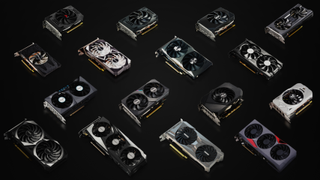Nvidia expects graphics card supply to improve in the second half of 2022
"We feel better about our supply situation as we move into the second half of the calendar year," says Nvidia's CFO.

Nvidia has been wrong about when graphics card supply will return in the past, though it's also one of the only companies on the planet that really has any idea what's going on. So it's definitely worth noting when Nvidia CFO, Colette Kress, says the second half of 2022 will be better for GPU supply than right now. Finally, some good news for gamers.
Last year, Colette Kress told us supply would remain lean through Q1 2021, and sadly the reality was it would remain lean through, well, the entire year of 2021. As we embark on 2022, not much has changed, though during a conference call Kress did outline some potentially positive news for GPU supply later this year.
"We had seen channel levels be quite lean," Kress says in response to a question about supply for gamers during the call (via Seeking Alpha, Tom's Hardware). "We are working with our supply chain partners to increase the availability of supply. And we feel better about our supply situation as we move into the second half of the calendar year '22."
Now, not many major chipmaking companies actually believe the chip shortage will be over by late 2022, though some have said they think the situation could at least improve by that time. A recent DigiTimes report expects GPU shipments to improve 10% in 2022. That's not much of an improvement, but it is an improvement.
Intel's CEO, Pat Gelsinger, more or less expects supply to remain tight until 2023, when itself and others like it (TSMC, Samsung) can actually get more manufacturing capacity online to meet demand.

Last year, we spoke to a supply chain expert to find out why you still can't buy a graphics card.
It's slow-going in chipmaking. Fabs aren't built in a day, and even if they were, it would cost a whole lot of money and add probably a bit too much risk to some companies to wish to build them. No chipmaker wants to build capacity then find the massive demand slips away before they can sell the increased number of chips it's producing.
That doesn't bode well for gamers, and I'm sure it's not what anyone wants to hear, but it's the sad reality of the situation that has left PC gaming worse for wear over the past two years. There is a light at the end of the tunnel, however, as demand will be satiated by supply one day—it's more a matter of when, and how long will we have to overpay for graphics cards in the meantime.
The biggest gaming news, reviews and hardware deals
Keep up to date with the most important stories and the best deals, as picked by the PC Gamer team.

Jacob earned his first byline writing for his own tech blog. From there, he graduated to professionally breaking things as hardware writer at PCGamesN, and would go on to run the team as hardware editor. He joined PC Gamer's top staff as senior hardware editor before becoming managing editor of the hardware team, and you'll now find him reporting on the latest developments in the technology and gaming industries and testing the newest PC components.
Most Popular






